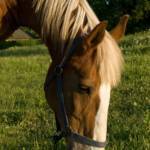What Grasses Do Horses Prefer?

Hungry horses will try a bite of just about anything green, but given their choice, what type of grass do they find most appealing?
In a study conducted at the University of Minnesota, four horses were allowed to graze cafeteria-style on different types of cool-season grasses. The trial was conducted from May through October, during which time the researchers visually assessed which plots were grazed most often, how much grass was removed, and the percent of ground cover remaining.
In this study, the horses showed a preference for Kentucky bluegrass, timothy, and quackgrass. They didn’t seem to care for orchardgrass, creeping foxtail, or meadow bromegrass. Reed canarygrass, perennial ryegrass, tall fescue, meadow fescue, and smooth bromegrass fell into the moderately preferred group of grasses.
Land owners want to provide palatable forage, but they also need to have grass types that will hold up well to heavy grazing through spring, summer, and fall. In this trial, tall fescue, orchardgrass, and meadow fescue were the most persistent grasses. Creeping foxtail and timothy did not persist well, while quackgrass, perennial, ryegrass, reed canarygrass, meadow bromegrass, Kentucky bluegrass, and smooth bromegrass showed moderate persistence under this grazing pressure. These conclusions vary somewhat from the results of a similar study conducted at the University of Kentucky.
The researchers suggested that a pasture mix of fescue, bluegrass, bromegrass, and ryegrass would provide horses with appealing grazing choices while keeping pasture ground cover in acceptable condition.








